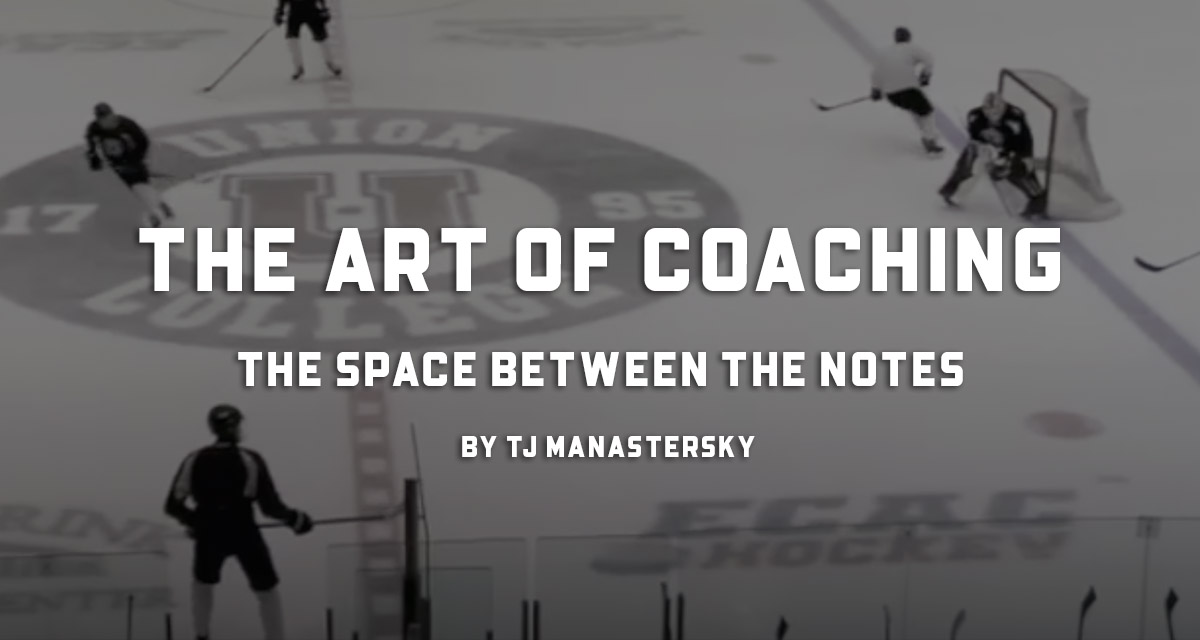
This article was written by TJ Manastersky, Assistant Coach at Union College.
The craft of coaching is both an art and science. Each season, coaching becomes more sophisticated as we are exposed to new technologies and attempt to find an edge. This leads to an expectation of coaches to modernize their approach. Yet, the best coaches seem to connect with their team in a way that inspires performance and it has little to do with tactics, data, or new technology. Successfully navigating the tension between the art and science of coaching is the craft of coaching.
This tension is found in the debate between analytics and the “eye test”. Knowing how to collect and interpret relevant data about individual and team performance can provide a competitive advantage. Being able to successfully implement the findings, blended with the personality and experience of the coach makes the difference.
Understanding the science and knowing how and when to implement coaching interventions requires experience, reflection and knowing your team. The art of coaching is developed through effort, mistakes, and triumphs.
“If you want to be a good archeologist, you have to get out of the library,” - Indian Jones in Kingdom of the Crystal Skull (video below)
Feedback and Direct Coaching
An impactful way to leverage the art of coaching is in the daily interactions with players. It’s knowing how and when to communicate with the team and individuals to maximize motivation and performance. It requires being able to read the energy of an individual and the team as a whole.
The role of feedback and direct coaching has a considerable impact in how coaching is received by the athlete. According to Wade Gilbert, professor of Coaching and Sport Psychology at California, State University, Fresno, research has shown good coaches give 50% less comments to athletes. These coaches listen first and intervene second.
There are times to push, demand effort and hold people accountable to successful behaviors and there are times when you should back off and create space for the athlete. The space provides freedom to reflect, self-organize, and problem solve.
Space Between the Notes
There is an interesting connection between the dynamic of direct coaching and how we experience music. The space between the notes defines music just as much as the notes do. The moments of silence draw you in, capture your attention, surprise you, create suspense, and ultimately impact your experience completely.
Miles Davis, the famous jazz artist was known to be fearless about using the space between the notes. His original video for “So What,” is a captivating example (video below).
Just like music is incomplete without the moments of silence, the art of inspiring performance over the long-term requires that we provide space for learning; an opportunity for self-discovery, problem solving, and exploration.
How to use space to inspire performance and growth
1) Player Development
- Empower the athlete to solve problems on their own.
- You can start by asking better questions.
- Self-directed learning and autonomy invite passion into the growth process. Give them the power to take responsibility for their own development. In this video below, I provide a simple framework for players to reflect and self-assess their development.
2) Practice Planning and Implementation
- Use other voices: empower assistant and junior coaches and provide opportunities for peer-to-peer coaching. Learning to leverage other voices will bring strength to your words when it is time to speak.
- Small sided games: through the use of constraints and affordances the game can be the teacher.
- As a example, the game, 4 v 2 Two-Touch, the attacking team learns to move the puck quickly and the defending team learns to identify pressure situations to take away space. All without the coach saying a word. The whiteboard explanation of the 4 v 2 Two-Touch can be viewed below.
3) Game Day
- Create opportunities for the players to have a voice in preparing for contests. Challenge them to watch video of the opponent in advance and ask them what they see.
- What are they good at? What are our opportunities? What can we anticipate?
- Limit your pre-game talks to 2-3 points. Max!
- Know your personnel “KYP” – some people respond well to direct coaching in the heat of battle and others need space to reflect on their own. Knowing your players and their story will help you create a feel for the situation, leading you to master the art of coaching.
Providing space in the right way at the right time is an art form. The first step is being aware that it is necessary.
The article above was written by TJ Manastersky of Union College. You can learn more and connect further with TJ by clicking the links below:
- TJ Manastersky's IHS Contributor Page (includes drills, articles and additional content from TJ)
- Follow TJ on Twitter
- Subscribe to TJ's Coaching Project Newsletter
- Listen to the TJ's Coaching Project Podcast

